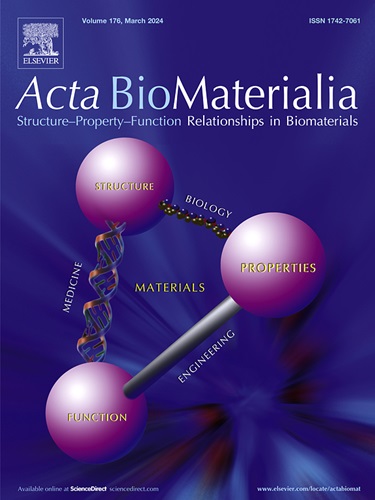Mechanical characterization of nonlinear elasticity of growing intestinal organoids with a microinjection method
IF 9.4
1区 医学
Q1 ENGINEERING, BIOMEDICAL
引用次数: 0
Abstract
Mechanical properties of intestinal organoids are crucial for intestinal development, homeostatic renewal, and pathogenesis. However, characterizing these properties remains challenging. Here, we developed a microinjection-based method to quantify the growth time-dependent nonlinear elasticity of intestinal organoids. With aid of the neo-Hookean hyperelastic constitutive model, we discovered that the global elastic modulus of intestinal organoids increased linearly during the early stages of culture, followed by a sharp rise, indicating a time-dependent nonlinear hardening behaviour during growth. The global modulus of intestinal organoids was found to correlate with the cell phenotype ratio, revealing a significant relationship between mechanical properties and biological phenotypes. Furthermore, we developed a biomechanical model on the basis of the unsteady Bernoulli equation to quantitatively explore the global mechanical responses of intestinal organoids, which showed good agreement with the experimental data. The work not only elucidated the mechanical response and modulus characteristics of small intestinal organoids from a biomechanical perspective, but also presented a new microinjection-based methodology for quantifying the mechanical properties of organoids, offering significant potential for various organoid-related applications.
Statement of significance
Mechanical properties of intestinal organoids are essential for intestinal development, homeostatic renewal, and pathogenesis. However, how to quantitatively characterize their global mechanical properties remains challenging. Here, we developed a new microinjection-based experimental platform to quantify spatiotemporal dynamics of mechanical responses and global elasticity of intestinal organoids. Unlike traditional nanoindentation methods, the proposed characterization technique can quantitatively measure the global mechanical properties of organoids, which is crucial for detecting the inherent relationship between the global mechanical properties and the biological phenotypes of organoids. Likewise, it established a methodological foundation for revealing the mechanobiological characteristics associated with the growth and development of various organoids. This can enhance our understanding of mechanobiological mechanisms of organoids and is beneficial for various organoid-related applications.

微注射法研究生长肠道类器官的非线性弹性力学特性。
肠道类器官的机械特性对肠道发育、体内平衡更新和发病机制至关重要。然而,表征这些特性仍然具有挑战性。在这里,我们开发了一种基于微注射的方法来量化肠道类器官的生长随时间的非线性弹性。借助neo-Hookean超弹性本构模型,我们发现肠道类器官的整体弹性模量在培养的早期阶段呈线性增加,随后急剧上升,表明生长过程中存在随时间变化的非线性硬化行为。发现肠道类器官的总模量与细胞表型比相关,揭示了力学性能与生物表型之间的显著关系。此外,基于非定常伯努利方程建立了生物力学模型,定量探讨了肠道类器官的整体力学响应,该模型与实验数据吻合较好。该研究不仅从生物力学的角度阐明了小肠类器官的力学响应和模量特征,而且提出了一种新的基于微注射的方法来量化类器官的力学特性,为各种类器官相关应用提供了重要的潜力。意义声明:肠道类器官的机械特性对肠道发育、体内平衡更新和发病机制至关重要。然而,如何定量表征它们的整体力学性能仍然是一个挑战。在此,我们开发了一个新的基于微注射的实验平台来量化肠道类器官的力学响应和整体弹性的时空动态。与传统的纳米压痕方法不同,本文提出的表征技术可以定量测量类器官的整体力学性能,这对于检测类器官整体力学性能与生物表型之间的内在关系至关重要。同样,它为揭示与各种类器官生长和发育相关的机械生物学特征奠定了方法论基础。这可以增强我们对类器官的机械生物学机制的理解,并有利于各种类器官相关的应用。
本文章由计算机程序翻译,如有差异,请以英文原文为准。
求助全文
约1分钟内获得全文
求助全文
来源期刊

Acta Biomaterialia
工程技术-材料科学:生物材料
CiteScore
16.80
自引率
3.10%
发文量
776
审稿时长
30 days
期刊介绍:
Acta Biomaterialia is a monthly peer-reviewed scientific journal published by Elsevier. The journal was established in January 2005. The editor-in-chief is W.R. Wagner (University of Pittsburgh). The journal covers research in biomaterials science, including the interrelationship of biomaterial structure and function from macroscale to nanoscale. Topical coverage includes biomedical and biocompatible materials.
 求助内容:
求助内容: 应助结果提醒方式:
应助结果提醒方式:


